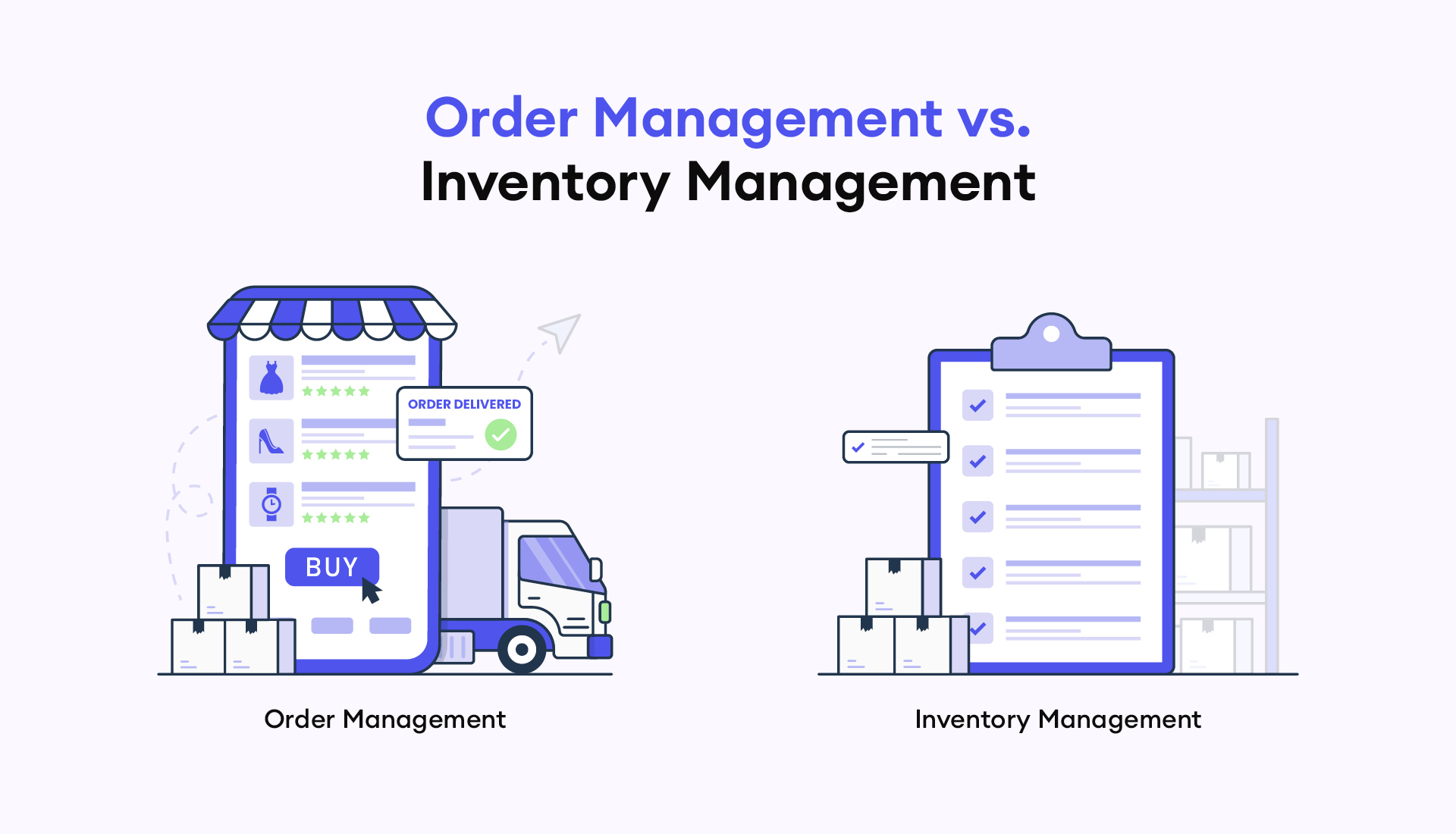Order Management vs. Inventory Management: What`s The Difference?

These two terms come up a lot in ecommerce, and while they’re closely connected, they serve very different purposes.
Think about it: today’s ecommerce landscape is more complex than ever. You’re likely selling across multiple channels, such as Shopify, Amazon, and maybe even wholesale. Customers expect products to be in stock and shipped at lightning speed.
To keep up, you need to know exactly what you have available, where it’s stored, and how to get it into your customer’s hands quickly and accurately. That’s where inventory management and order management come in.
Here’s a simple way to picture it:
Order management is everything that happens from the moment they click “Buy Now” to the moment the sneakers arrive on their doorstep.
Inventory management is what made sure you actually had the sneakers in stock to sell in the first place.
By the end of this post, you’ll have a deeper understanding of both order management and inventory management, how they work together and why both are essential for keeping your ecommerce business running smoothly.
What Is Order Management? (Keeping Every Order on Track)
Order management is the process of handling every step of a customer’s purchase, from the second they place the order until the package is delivered. Think of it as your playbook for keeping orders from slipping through the cracks.
Here’s what it usually includes:
Order capture: Bringing in purchases from your sales channels (Shopify, Amazon, eBay, etc.).
Order routing: Sending the order to the right warehouse or fulfillment center based on proximity, shipping costs, and delivery commitments.
Fulfillment & shipping: Picking, packing, and shipping the right items quickly and accurately.
Shipping confirmations & notifications: Keeping customers in the loop with tracking updates.
Reverse order management: Handling returns smoothly, also known as reverse logistics.
If even one step breaks down, the ripple effect shows up fast: late shipments, wrong products, frustrated buyers.
Taking the time to strengthen your order management systems will help you make sure your customers always get the right product, on time, without any hassle. This means you’ll not only make more revenue, you’ll also strengthen your reputation and retain happy customers who keep coming back.
Want to learn more about optimizing your Order Management System? See our helpful guide, How To Set Up An Order Management System (OMS) That Scales With Your Ecommerce Business.
What Is Inventory Management? (Knowing What’s in Stock, and Where It Is)
Think of order management as what the customer sees, and inventory management as the engine running behind the scenes. It’s all about knowing what products you have, how much you have, and where it’s stored. Inventory Management is the system behind the scenes that keeps your shelves stocked and your cash flow steady.
Here are the main pieces:
Stock levels: Tracking quantities across all warehouses, stores, or fulfillment centers.
Reordering & forecasting: Knowing when to restock and predicting future demand.
Avoiding stockouts or overstocking: Striking the balance so you don’t miss sales or tie up money in unsold products.
Optimizing storage: Making the most of your warehouse space to keep operations efficient.
Good inventory management protects your profits and keeps your customers happy. If you don’t manage stock well, you risk running out of popular products, or getting stuck with items that gather dust on your shelves.
Worried about running out of items? Read “Avoiding Stockouts 101: How to Prevent Leaving Customers Empty-Handed.”

The Key Differences
While order management and inventory management work hand in hand, they’re not the same.
Here’s your handy cheat-sheet for remembering the differences:
Focus:
Order management = customer-facing, starts at checkout, ensures smooth delivery.
Inventory management = internal-facing, ongoing, ensures stock is accurate.
Workflow:
Order management starts when the customer clicks “buy.”
Inventory management is ongoing, happening in the background.
Customer impact:
Order management = smooth checkout and fast delivery.
Inventory management = products available when customers want them.
How They Work Together
While inventory management and order management are different, they rely on each other to keep your ecommerce business running smoothly.
Here’s the simple connection in action:
Inventory management ensures you always know what’s in stock, what’s running low, and which items are overstocked.
Order management uses that data to pick, pack, and ship the right products to the right customers at the right time.
When the two systems aren’t aligned, mistakes happen fast:
Overselling: A customer orders an item that your system shows as available but is actually out of stock. This leads to backorders, delays, and unhappy customers.
Excess inventory: Stock sits unsold in a warehouse because orders aren’t flowing properly through your system, tying up cash and storage space.
Fulfillment errors: Orders shipped with the wrong items because the system didn’t provide accurate stock information to the picking team.
When inventory and order management work in tandem, the benefits are immediate:
Seamless operations: Orders are fulfilled accurately and on time, every time.
Scalability: You can grow your business across multiple channels without adding chaos to your fulfillment process.
Informed decisions: Accurate inventory data helps you forecast demand, optimize stock levels, and reduce costs.
That’s why modern ecommerce software (like Goflow) brings both processes together in one platform. You get real-time visibility into your stock and a streamlined system for handling orders, so you can consistently meet customer expectations and turn first-time buyers into loyal fans.
Order Management vs Inventory Management: Explained
Now you know the difference between order management and inventory management, and why both are so important for running a profitable, customer-friendly ecommerce business.
In short, inventory management and order management aren’t just complementary. They’re two halves of the same operation. When both systems are aligned, your business runs like a well-oiled machine, keeping customers happy and profits healthy.
Customers always find the products they want in stock, their orders arrive on time, and your business avoids the costly pitfalls of stockouts, overstock, or fulfillment mistakes. In today’s competitive ecommerce environment, this is a major differentiator that helps you build loyalty, protect your margins, and scale confidently.
With Goflow, you can simplify both processes, reduce stress, and run your operations more efficiently. You’ll get real-time visibility into your inventory and a streamlined system for handling orders, so you can spend less time worrying about logistics and more time focusing on growth.
To see Goflow in action, book a live customized demo here.
